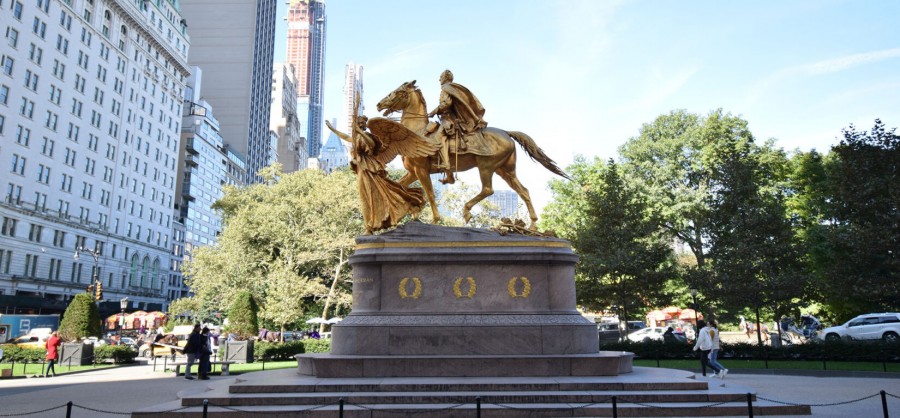It is the world's largest outcropping of granite, and on its northeastern elevation, is the world's largest bass relief carving, nearly three football fields long and 90 feet tall, a trio of Confederate leaders, President Jefferson Davis, General Robert E. Lee, and General Stonewall Jackson, facing the eastern horizon on horseback. The Stone Mountain monument shares its initial sculptor with Mount Rushmore.
And today, one of America's and certainly Georgia's most visited 'rock groups' has something new directly in their line of sight, almost at the feet of their famed steeds. In Valor Park, at the base of the long Memorial Hall lawn, is a circle of battle flags of the Confederacy, all in turn slightly yielding to a taller flag pole, containing the flag of the United States of America.
This carving was begun in the 1920s, and in part intended as a bookend to the Lincoln Memorial (started in 1914 and dedicated in 1922), originally financed in part by a commemorative coin issued by the U.S. Treasury. But the Southern effort ran out of funding, its carver left for the Dakotas, and the project languished for decades, finally reaching completion in 1970, at least partially driven by the state's reaction to the Civil Rights movement of that day. History itself may not change, but the parts of it we are willing to share and retell are constantly in motion, and certainly not set in stone.
Among the most visited spots on the park itinerary is the mountain's 1.5-mile walk-up trail to the summit, featuring spectacular skyline views of the City of Atlanta, roughly 12 miles to the west. And prominently positioned at the base of that trail is a flag plaza, donated in the early 1960s by the United Daughters of the Confederacy, and until a few days ago featuring four battle flags of the Confederacy, including the best known, the Virginia battle flag, colloquially known as 'the Stars & Bars' of the Confederacy. Today, though that donated platform and pedestals remain in place, now only three flags fly, the U.S. flag, with a pair of Georgia state flags on each side. And now, roughly one-mile east, at the carving's base, and just under their watchful gaze, in perfect position for a Millenial selfie, are those four battle flags, now relocated to Valor Park, a location of equal prominence, and joining a cluster of other Confederate memorials and monuments nearby.
Our U.S. Civil War remains the most costly in loss of American lives, 200,000 more than WWII, from a much younger nation with a population smaller by millions. The vast majority of Confederate troops never owned slaves and though many initially volunteered for battle, in later years of the five-year conflict, juvenile-aged males were being conscripted. Whether viewed as martyrs, traitors, or valiant warriors for their home states, there is no question of the loss which occurred for the survivors and families of those troops fighting for that Lost Cause.
Memorial Day began as a Confederate war dead remembrance, in Columbus, Georgia, and Columbus, Mississippi in 1866. Union commemorations would not commence until years later and originally were entitled Decoration Day or Declaration Day across the country. By 1916, 16 states celebrated Confederate Memorial Day, most typically during the last week of April, while the Union Memorial commemorations were most often held in late May. It would not be until 1967, a century after the Civil War, when Congress and President Lyndon Johnson would declare Memorial Day as a federal holiday, to be observed on the last Monday in May.
Today’s leaders of the Stone Mountain Memorial Association (SMMA) understand that Arlington National Cemetary sets atop the one-time plantation of General Robert E. Lee, as well as the fact that 150+ years later some wounds remain weeping and fresh. Instead of subtracting or erasing history or markers left by prior generations, the SMMA is making additions to this park and Confederate Memorial.
A hand-crafted wooden covered bridge, engineered and built by Washington W. King, the son of a freed slave has been added to the National Register of Historic Places, a 'truth-telling' museum exhibit is under development to share warts and all history of the mountain carving and other Lost Cause mythology, and there are other more nuanced projects in process to both reposition the park, and to make it more welcoming for those who may well find the gaze of that Confederate trio, unwelcoming. Again, addition, versus subtraction, as there is plenty of room for everyone there among the 3,400 acres of Stone Mountain Park, 4 times the size of New York's Central Park, which still includes a gold-gilded statue of General William Tecumseh Sherman at its main entrance.










